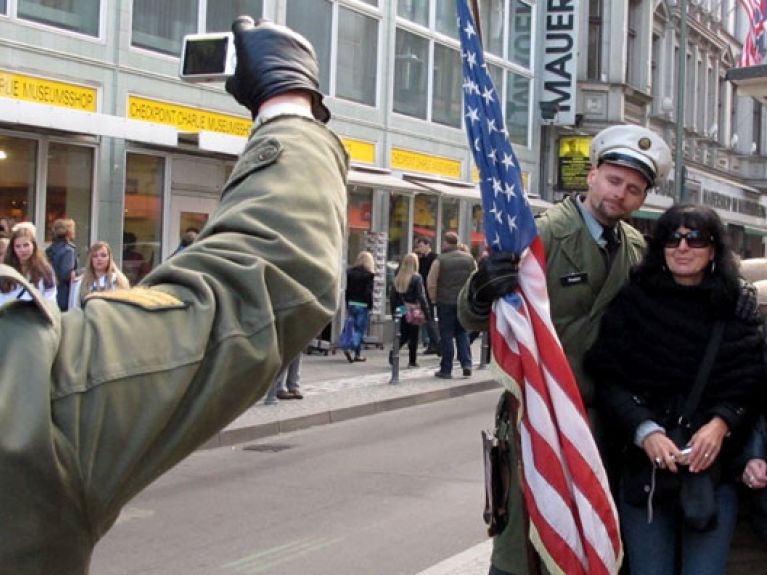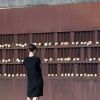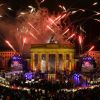Searching for Clues in Berlin-Mitte
More than 20 years after the fall of the Wall there are still traces of the two Germanies’ history in the Berlin-Mitte district.

Berlin-Mitte. At the beginning of the 1990s many people fell in love with this district at the heart of the city. In those days the capital symbolized the end of the Cold War. And Berlin-Mitte was the flashpoint of this momentous worldwide change. During the GDR years this district experienced a bizarre kind of reality: on the one hand, as the centre of the city; on the other, as a rigorously guarded border area between east and west. It included both the grand old boulevard Unter den Linden and Checkpoint Charlie, one of Berlin’s most famous border crossing points. When the Wall came down in 1989 the district was completely transformed. Party-goers from neighbouring Kreuzberg moved in to the rhythms of techno music. Around Auguststrasse, not far from the New Synagogue in Oranienburger Strasse, artists settled and opened galleries. The big shopping centres now enhanced the elegance of Friedrichstrasse and Unter den Linden, whereas before they were concentrated along the Kurfürstendamm, the showcase of the west beyond the Iron Curtain. And finally, Germany’s political hub moved to Berlin-Mitte in 1999. Since then the country’s political heart has been beating here at the Federal Chancellery, the Bundestag in the historical Reichstag building and the many offices of members of the Bundestag.
In the 1990s Berlin-Mitte was the location of innumerable construction sites. Not much is left now of the old Berlin, where scars from the Second World War were still very visible at virtually every corner. The new facades in pastel shades no longer bear the traces of machine-gun volleys. Above all, the depressing charm of the dilapidated environment has vanished – the drab greyness, sparsely decorated with red-brick stripes, which had more or less evolved into East Berlin’s trademark. The decades of neglect, to which the GDR had condemned a large part of this district, were made good within just a few years. Nevertheless, there are still many places where history is alive, visible and ready to be experienced. There are museums, memorials and monuments, often located along the line once drawn by the Wall. Anyone searching for traces of the two Germanies’ past will soon make discoveries – for instance, at Bernauer Strasse, which was once a dividing line between East and West Berlin.
Bernauer Strasse is probably the place where the construction of the Wall most brutally invaded the everyday lives of Berliners. It’s where the Wall ran directly beneath the long row of houses, leading to surrealistic situations: the road lay in the west, but the apartments on one side belonged to the east. Their western facing windows overlooking the street were seen as a threat in the eyes of the GDR regime. They began by bricking up the first-floor apartments and later cleared the others of occupants in dramatic operations. The first sections of the Wall were constructed during the night of 13 August 1961. A few weeks later, on 25 September, 77-year-old Frieda Schulze escaped to the west from one of these apartments by jumping from her first-floor window at 29 Bernauer Strasse. Firemen from the western part of the city were waiting below with a safety sheet. Mrs. Schulze survived. She was lucky. Other people died when they jumped from windows and rooftops. A tunnel was also dug beneath Bernauer Strasse enabling 57 people to escape to the west. The Berlin Wall Memorial, which was erected in memory of the divided city in 1998, now acts as a reminder of those times. It is both a memorial and an information centre. And it is the only place that shows what the Wall actually looked like.
The impressions become less gloomy as the search for traces of the past takes us away from the course of the Wall towards the centre of Berlin-Mitte and the Television Tower at Alexanderplatz. Torstrasse, Rosenthalerplatz, Tucholskystrasse: it is here, in the streets inhabited by the sleazy characters of Alfred Döblin’s novel Berlin Alexanderplatz some 90 years ago, that a good deal of Berlin’s current nightlife can be found. Hardly any traces of the divided city are visible here now. It’s where the city of today is alive and throbbing: just a few steps away from the bustle of Oranienburgerstrasse, Berliners, newcomers and tourists meet in a multitude of small cafés, bars and restaurants. A brief stopover here is enough to make you want to say: “Ich bin ein Berliner.” The openness of the people and the feeling of freedom that literally hangs in the air characterize the atmosphere of reunited Berlin in this area.
Unter den Linden, Gendarmenmarkt, Friedrichstrasse: elegant restaurants, cool cafés, shopping galleries and luxury stores – today, everything here again looks like it should in a major city. Close by is Checkpoint Charlie, a big tourist attraction, a museum in front of which tour guides clad in Soviet or American uniforms talk about divided Berlin’s history. There’s almost a coastal atmosphere at the East Side Gallery, because it runs for one-and-a-half kilometres alongside the River Spree. It consists of a section of the Wall covered in paintings and located almost on the border between the districts of Mitte and Friedrichshain. The river bank here is dotted with little sandy beaches. It’s where Berliners sunbathe in deckchairs in the summer. Where the sunshades now crowd together, searchlights once swept across the river and GDR border guards patrolled the bank. Berlin celebrates freedom. Every day.
Paolo Petrillo is German correspondent of Italian daily newspaper Il Riformista.

